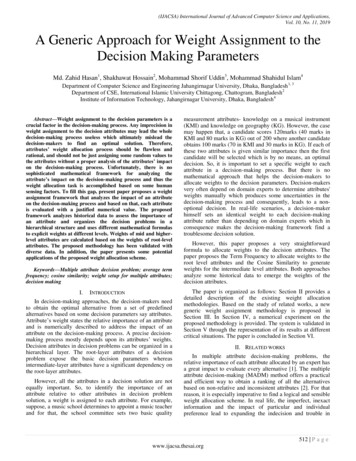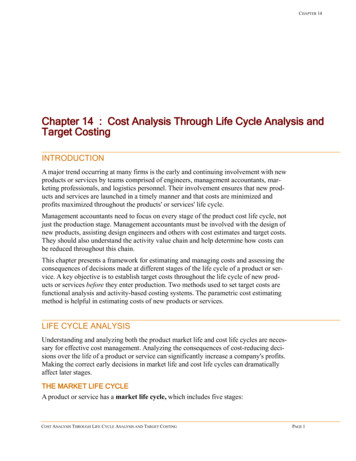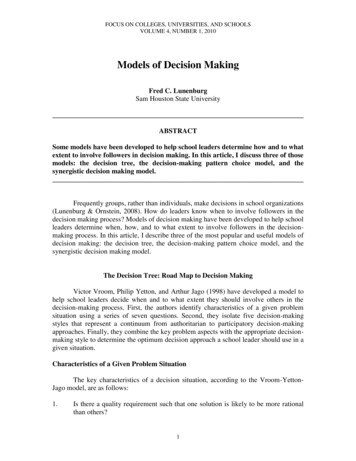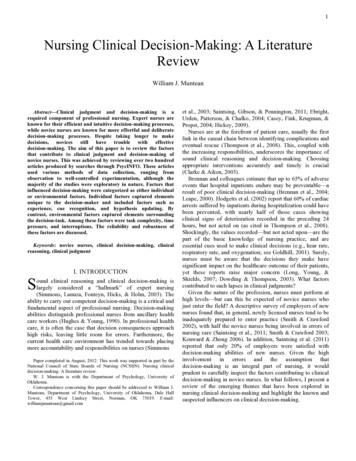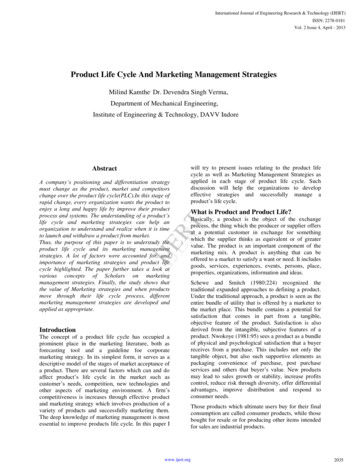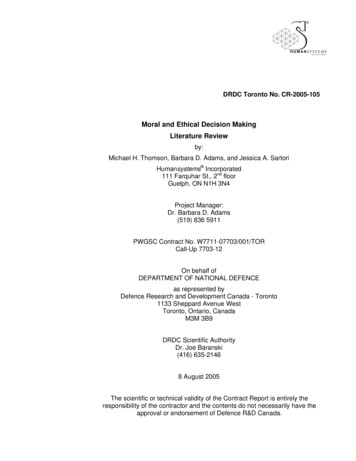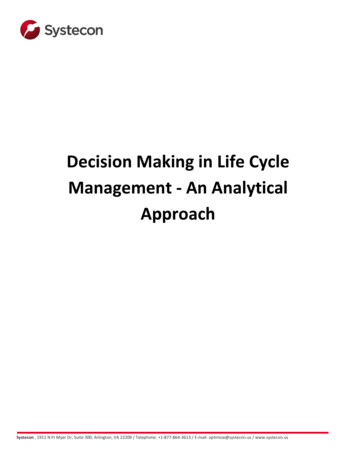
Transcription
Decision Making in Life CycleManagement - An AnalyticalApproachSystecon , 1911 N Ft Myer Dr; Suite 300; Arlington, VA 22209 / Telephone: 1-877-864-3613 / E-mail: optimize@systecon.us / www.systecon.us
Decision Making in Life Cycle Management An Analytical Approach1 AbstractHow do you make sure that availability & performance of your systems meet operationalrequirements, and that the cost for achieving it is not too high? Throughout the life cycle ofan advanced technical system, like an aircraft, ship, train or power plant, countless decisionsare made which have major impacts on both overall performance and total ownership cost.Understanding how each decision contributes to both cost and readiness is critical.Surprisingly often, such decisions are based on gut feeling only, or on very limited analyses.One reason may be that it is perceived to be too difficult and/or time consuming to get properdecision support. Lack of qualified data and uncertainties in early phases are seen to make itimpossible to conduct meaningful research. In most situations however, decision support isnot focused on providing exact answers, but rather on choosing the right direction goingforward. Therefore, even analyses based on rough estimates, approximations and analogiescan make the difference between failure and success.This paper outlines the fundamentals of successful Life Cycle Management, a method tomonitor your systems towards fulfilling operational needs at the lowest possible TotalOwnership Cost. The paper discusses critical decision points in different phases of thesystems life cycle and suggests an approach to use modelling and simulation software toanswer key questions and provide the required decision support.2IntroductionProcurement and ownership of advanced technical systems such as aircraft, ships, trains andpower plants are associated with huge investment costs, high complexity and substantialcosts for operations and maintenance over the life cycle of the system.Early decisions regarding concepts, requirements and choice of supplier will impact theTotal Ownership Cost (TOC) more than anything else. Unfortunately, these decisions needto be made without exact knowledge about all influencing parameters. To make these kindsof decisions under major uncertainties calls for an efficient and systematic decision-makingprocess, using modeling and simulation tools to analyze the consequences of the decisions.Another obvious conclusion is that there is a need to continuously monitor and control thesystems over their life cycle to gain as much benefit from each system as possible. At thesame time the costs associated with developing, owning and using the systems also needs tobe monitored and if possible minimized.We call this continuous process Life Cycle Management (LCM) as we look upon it as amanagement process or a tool to monitor the system towards fulfilling the operationalneeds at the lowest possible TOC, thus creating more affordable systems for the users.2 (11)
Decision Making in Life Cycle Management An Analytical Approach3LCM in theory and practiceAs stated above, Life Cycle Management (LCM) is a method to manage the system towardsfulfilling the operational needs at the lowest Life Cycle Cost (LCC). Various LCMapproaches has been used by several organizations for many years. Our experience ishowever that most organizations don’t benefit from the full potential of applying properLCM. Some of the most common pitfalls are: LCC is used for accounting/budgetary purposes only, not to support decisionsOperations and maintenance qualities are not addressed early enoughDecisions are made without proper consequence analyses, for example modellingand simulationPoorly defined requirements that are either not relevant or creates contradictoryincentivesTo understand how to apply proper LCM and to avoid the pitfalls it is important tounderstand the fundamental mechanisms that need to be addressed.To begin with, the driver for system acquisition and development should be the user s need.The air force has to be able to produce a certain amount of flying missions, the train operatorwants to be able to run a train fleet according to a time table and the energy producer wantshis power plants to be up and running all the time. In addition, common for all users is theneed to be efficient, i.e. be able to fulfil the needs to the lowest possible cost.The user s need can be translated into operational performance of the system which isdefined as a combination of the technical capabilities and the availability, which is the extentto which the system is actually able to deliver its performance when asked for. The difficulttask that we focus on in this paper is to make sure that the availability performance is goodenough and the cost for achieving the required availability level is as low as possible.How can we do that? One obvious way is to make sure that the system doesn’t break toooften, and that the preventive maintenance needed to keep it running is not required toooften. We call this reliability. Reliability is a factor defined by the system design that has tobe taken into account from the beginning when designing a system. When acquiring a newsystem that has already been designed, you need to make sure that you understand whetherthe reliability has been an important design parameter or not. Poor reliability is a significantcost driver from a TOC point of view.The next way to ensure that the availability performance is good enough is to minimize thedowntime when a failure occurs, or a planned maintenance task is performed.Downtime has to do with two things, and one of them also has to do with the systemdesign. It is called maintainability and determines how easy and fast it is to performmaintenance tasks. The world is full of examples of systems where the design engineers3 (11)
Decision Making in Life Cycle Management An Analytical Approachclearly have not understood the impact of a certain design for the maintenance technicians,which has led to systems that are very complicated and time consuming to maintain.The other part of downtime depends on how we organize the logistic support of the system,and how much logistic support resources that we will need – the supportability. We can tosome extent compensate poor reliability and maintainability with more logistic supportresources to achieve the same level of availability performance. However, there will be acost impact, not only to invest in all the extra resources, but also to perform all the repairsand planned maintenance tasks over the systems life cycle. Thus, it is possible to make atrade-off between system design and design of the logistic support system. The picture belowillustrates the mechanisms and trade-offs needed to optimize operational performance.Figure 1. Operational performance and how to influence it.To summarize this introduction to LCM in theory and practice: Availability performance has big impact on the user’s ability to perform the tasksand operate the system as planned, i.e. on the operational performanceAvailability performance is best influenced in early system design by focusing onreliability and maintainability aspects of the design.Poor reliability and maintainability can be compensated with more logisticsupport resources and more maintenance, but often at a high priceThe availability performance has crucial impact on Life Cycle Cost (LCC) and theTotal Ownership Cost (TOC).4 (11)
Decision Making in Life Cycle Management An Analytical Approach4Life Cycle Perspective and Decision MakingThere are recognized international standards for system life cycle processes, like ISO 15288,however many of these processes will not give you any guidance on how to make decisions.In this paper we have chosen to focus on that perspective, the fundamental decision-makingprocess for balancing operational performance and total ownership cost.4.1 Impact of decisionsFrom a customer and owner perspective any system typically goes through several phasesstarting with concept definition, specification and acquisition, continuing with system designand development, production, entry to service, operations and maintenance and finallydisposal. All through the life cycle a program or product manager needs to make a lot ofdecisions regarding the technical system, its operations and maintenance and the logisticsupport. The important point here is that consequences of decisions made will not come indaylight until many years after a decision is made. That is the background to the classic LCCcurve below.Figure 2. Characteristics of the LCC-curve.The green curve shows the actual expenditures (both CapEx and OpEx) for a systemthroughout its life cycle. The red curve however, describes when your decisions make youcommit to the costs, which usually occur long before the actual expenditures. Thus, yourpossibility to influence the total ownership cost will decrease during the system s life cycleaccording to the blue curve.It is also important to point out that if decisions are made in later phases withoutanalyzing the potential consequences on operational performance and life cycle cost,there is a great risk that you commit to future cost increases.5 (11)
Decision Making in Life Cycle Management An Analytical Approach4.2 Data qualityOne issue when working with models is how to get relevant input data. Lack of data is one ofthe most common objections against using modelling and simulation. In most situationshowever, the required decision support is not exact answers, but rather understanding enoughto be able to choose the best direction going forward. Even analyses based on roughestimates, approximations and analogies can make the difference between failure andsuccess: The requirements for data accuracy and level of detail depend on thetype of decision to be made.There are proven ways to mitigate “lack-of-data”-issues.There is always knowledge available in your organization that canhelp you to calibrate input data and validate results.Sensitivity analyses and what-if analyses will help you toevaluate the implications of data uncertainty and hence focus onthe most significant variables.The correct approach is to make use of the best available data and expand and refine themodel as more knowledge and experience is gained from within your organization and fromyour suppliers. The picture below lists a few generic approaches that can be used in differentstages.Figure 3. Methods to create data of better and better quality.As a general recommendation, start with a high-level model using rough data. The analysiswill then support you in identifying what data is most important for the decision at hand.You can then put your effort to gain better data quality in the most important6 (11)
Decision Making in Life Cycle Management An Analytical Approachareas. As data quality will improve during a program you can gain from using this tofurther detail and improve your models.5Systecon s analytical approach to LCMWhen should you replace a fleet of systems? What requirements should be put on a newsystem? Which system should you purchase? What investments in logistic support, sparesand other resources should be chosen? What improvements are most cost-effective to make toenhance my operations?These are some examples of major questions for a system manager. They all require anunderstanding of what the consequences of the choices at hand will be on operationalperformance and total cost of ownership. The questions are complicated to answer sincethere are so many influencing parameters. The picture below illustrates the decisionproblem and the three main influencing domains.Figure 4. The dimensions that influence the relationship between cost and availability of your system.Each domain is complex to describe, and changes in one domain, for instance a newoperational profile, will often create a need for adjustments in the other domains to balancethe operational performance and TOC.To be able to assess consequences of alternative solutions in a systematic and consistentway throughout the system’s life cycle there is a need to use an analytical approachsupported by efficient decision support models.Systecon use a combination of tools to assess different aspects of a decision. Typically, theoptimization tool OPUS10 is used to identify the best logistic support solution from a costeffectiveness perspective and to optimize the spares assortment. The simulation tool7 (11)
Decision Making in Life Cycle Management An Analytical ApproachSIMLOX is used to validate sustainability and ability to handle different scenarios and todimension fleet size, personnel, repair equipment and other resources. The cost calculationtool CATLOC is used for LCC comparisons, identification of cost drivers, budgeting andcost analysis. These tools work together as a suite to provide decision support for each typeof decision and helps finding the optimal trade-off between cost and availability.6LCM Analytical work processA general approach when working with LCM analyses: Define your system and scope, the decision at hand and the alternative solutionsDefine prerequisites and limitations for operations and maintenanceDefine influencing parameters and create your modelAcquire input data. Begin with a rough data model.Validate the model and the data quality and improve data that has significantimpact on the decision at handPerform analyses and evaluate the resultsPerform sensitivity analysis, identify drivers of cost and effectiveness, iterate tofind the best solution6.1 Examples of decision points during the life cycleIn the early phases you make the major decisions which will commit most of the future lifecycle costs. This means that it is in the early phases that we need to put in most of the effort.Nevertheless, to achieve the availability performance and the life cycle cost that the earlydecisions have made possible, you need to carry on making decisions in a systematic waythroughout the rest of the systems life cycle. Otherwise, there is a great risk that you willsuffer from uncontrollable increasing costs or poor availability performance.Managing decisions over the life cycle with overall requirements and goals on macro levelin focus, modeling detailed data on micro level is a true-life cycle management challenge.The following chapters will take you through the systems life cycle to give a betterunderstanding of some of the major activities that you will face in each phase.8 (11)
Decision Making in Life Cycle Management An Analytical Approach6.1.1 Conceptual PhaseExamples of early LCM tasks in the Conceptual Phase: Define high level operational needs and requirementsEvaluate alternative strategies and system concepts and their LCC consequencesEvaluate alternative support conceptsDefine an LCM strategyEstablish a budget for initial acquisition of logistic support resources anda LCC budget estimate6.1.2 Acquisition PhaseExamples of LCM tasks in the Acquisition Phase: Translate operational needs into balanced specificationrequirements on availability performance, maintenance, logisticsupport and LCCDefine evaluation models and data needsSpecify support strategy and prerequisites for the acquisitionEvaluate tenders and negotiate contract terms6.1.3 Development and Production PhasesAn Integrated Logistic Support Program, ILSP, should be included in the contract to securethat the system design is analyzed, influenced and documented in a proper way. Thevarious analyses and reports that are produced within the ILSP can be used as a theoreticalverification of the requirements. A customer can also use this information to performanalysis and decide on the logistic support solution and what resources to acquire.9 (11)
Decision Making in Life Cycle Management An Analytical ApproachExamples of LCM tasks in these phases: Perform trade-off analyses between different design alternativesFollow up contractor deliveries and evaluate consequences on LCCVerify requirementsDesign logistic support systemOptimize the logistic support resources6.1.4 Operational PhaseExamples of LCM tasks in the Operational Phase: Establish a process for continuous improvements, analyze feedback, findbottlenecks and weaknesses in the support organization and makeimprovementsAssess your spares assortment and adjust to changing parameters,i.e. reallocation and replenishment of sparesAdapt to changes in the operationsDevelop support contractsEvaluate system modificationsUpdate your models - Re-calculate LCCAnalyze the optimal time for system replacement6.1.5 Disposal PhaseExamples of LCM tasks in the Disposal Phase: Analyze and adjust the logistic support solution during ramp down andsystem replacementWhen stop buying spare parts and instead cannibalize from other systems.When stop doing preventive/scheduled maintenance.10 (11)
Decision Making in Life Cycle Management An Analytical Approach7SummarySuccessful Life Cycle Management requires an ability to make well-informed decisionseven in situations with high uncertainty and lack of experience data. In this context, it isimportant to have an ability to identify, understand and influence the key parameters thatimpacts operational performance and life cycle cost. This can be accomplished through theanalytical approach provided in this paper, which is based on modelling and simulation ofthe operations and the logistics support scenarios. The approach makes it possible to balancedifferent qualities against each other from a cost effectiveness standpoint, compare differentsolutions, understand the consequences of decisions and navigate towards the best possiblesolution with a life cycle perspective.The rapid changes in technology and behavior are of course being reflected in Systecon, inour consultancy work and in the Opus Suite. Everything is faster, larger and more complex.The amount of available data, the complexity of the systems and deployment schemes andschedules are steadily growing and continuously changing at a faster rate. This means thateven more emphasis needs to be put on making the right decisions throughout the life cycle.This implies the need for being able to work with these issues effectively and to ensure thatanalyses of greater complexity are conducted more frequently. By doing this it will bepossible to maintain a competitive edge by increasing business value, ensuring highoperational availability and keeping costs down.To meet these rapid changes and reap the full benefits we need to integrate the work withLife Cycle Management more closely with the procedures of the client companies,authorities and organizations. This requires improvements of management aspects, analysiscapability and the integration with the underlying information flow; in other words, to beable to work with the cornerstones of LCM.It is more important than ever to be able to communicate analytical results so that they areaccepted and have an impact on organizations. To incorporate this in managementprocedures, it must be simple to understand, even for non-analysts, and furthermoreaccepted as important input in decision making. It is imperative to convey the importance,and relative simplicity, of the analysis.One key success factor will also be the ability to achieve a quick turnaround from questionto result. When a new scenario or new design is proposed, we need to be able to quicklygive a response in what this implies in terms of cost and effectiveness. To enable this, it willbe more important to have the analysis readily available through fast and seamlessintegration with the necessary data sources. We make it possible to speed up the analysis forlarger cases as well as answer new types of questions that arise. With Systecon all of this ispossible. We look forward to working with your organization to demonstrate our worldleading capability in LCM.11 (11)
As stated above, Life Cycle Management (LCM) is a method to manage the system towards fulfilling the operational needs at the lowest Life Cycle Cost (LCC). Various LCM . The availability performance has crucial impact on Life Cycle Cost (LCC) and the Total Ownership Cost (TOC). Decision Making in Life Cycle Management - An Analytical .

